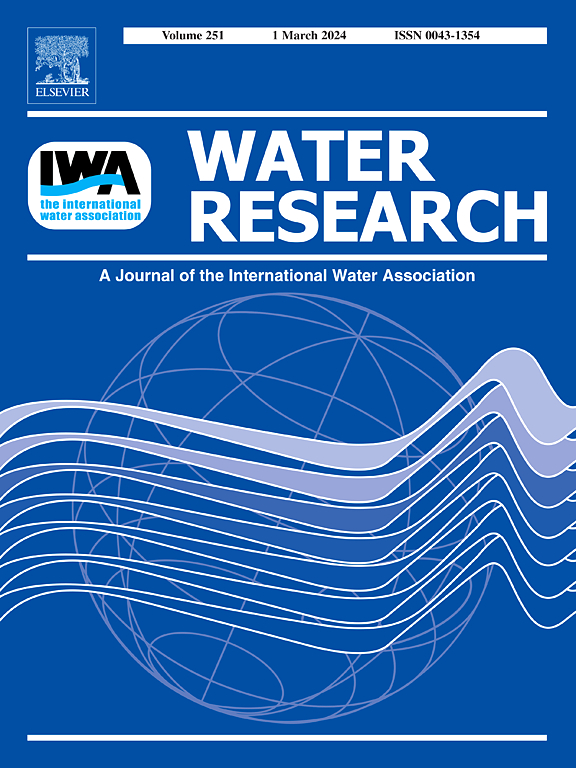日本某城市下水道系统污水监测显示的抗生素和耐药细菌的发生情况
IF 12.4
1区 环境科学与生态学
Q1 ENGINEERING, ENVIRONMENTAL
引用次数: 0
摘要
耐药细菌(ARB)的流行对公众健康构成了重大威胁。特别是,产生广谱β -内酰胺酶的大肠杆菌(ESBL-EC)和产生碳青霉烯酶的肠杆菌科(CPE)等多重耐药细菌的增加,限制了细菌感染的治疗选择,强调了对抗生素耐药性进行强有力监测的迫切需要。为了满足这一需求,我们在2022年1月至2024年3月期间对日本一个城市的33个市政下水道接入点的废水进行了调查,以评估那里目前的抗生素耐药性状况。对耐药大肠杆菌和抗生素的浓度进行了定量分析,总结了城市污水集水区的土地利用区划,并利用全基因组测序方法研究了ESBL-EC和CPE的遗传特征。下水道样本与五个下游污水处理厂的进水具有相似的抗生素耐药性特征。耐药大肠杆菌浓度与居民区相对丰度呈正相关,与工业区相对丰度呈负相关。下水道系统中左氧氟沙星和磺胺甲恶唑浓度与耐药大肠杆菌浓度呈正相关。ESBL-EC集中在城市,以序列型(ST) 38和ST131为主,以blaCTX-M-14和blaCTX-M-27基因为主。在几个下水道通道处发现了CPE,其中携带blaNDM-5的大肠杆菌是最常见的CPE。在科贝肠杆菌、密歇根克雷伯菌和准肺炎克雷伯菌中均可检出blaGES-24。此外,在溶鸟拉乌尔菌中还鉴定出两个新的blaGES等位基因(blaGES-63和blaGES-64)。本文章由计算机程序翻译,如有差异,请以英文原文为准。


Occurrence of antibiotics and antibiotic-resistant bacteria in a Japanese city revealed by wastewater surveillance in the sewer system
The prevalence of antibiotic-resistant bacteria (ARB) poses a significant threat to public health. In particular, increases in multi-drug-resistant bacteria, such as extended-spectrum beta-lactamase-producing Escherichia coli (ESBL-EC) and carbapenemase-producing Enterobacteriaceae (CPE), limit treatment options for bacterial infections, underscoring the urgent need for robust surveillance of antibiotic resistance. In response to this need, we surveyed wastewater at 33 municipal sewer access sites in a city in Japan during January 2022 to March 2024 to assess the current antibiotic resistance status there. Concentrations of antibiotic-resistant E. coli and of antibiotics were quantified, urban land-use zones of the sewer catchments were summarized, and whole-genome sequencing was used to investigate genetic characteristics of ESBL-EC and CPE. Sewer samples shared similar antibiotic resistance profiles with the influent of five downstream wastewater treatment plants. Antibiotic-resistant E. coli concentrations were related positively with the relative abundance of residential zone and negatively with that of industrial zone. Levofloxacin and sulfamethoxazole concentrations were correlated positively with antibiotic-resistant E. coli concentrations in the sewer system. ESBL-EC were pooled in the city, where sequence type (ST) 38 and ST131 were prevalent and the blaCTX−M-14 and blaCTX−M-27 genes were predominant. CPE were identified in several sewer access sites, where E. coli carrying blaNDM-5 were the most prevalent CPE. blaGES-24 was frequently detected in Enterobacter kobei, Klebsiella michiganensis, and Klebsiella quasipneumoniae. Moreover, two novel blaGES alleles (i.e., blaGES-63 and blaGES-64) were identified in Raoultella ornithinolytica.
求助全文
通过发布文献求助,成功后即可免费获取论文全文。
去求助
来源期刊

Water Research
环境科学-工程:环境
CiteScore
20.80
自引率
9.40%
发文量
1307
审稿时长
38 days
期刊介绍:
Water Research, along with its open access companion journal Water Research X, serves as a platform for publishing original research papers covering various aspects of the science and technology related to the anthropogenic water cycle, water quality, and its management worldwide. The audience targeted by the journal comprises biologists, chemical engineers, chemists, civil engineers, environmental engineers, limnologists, and microbiologists. The scope of the journal include:
•Treatment processes for water and wastewaters (municipal, agricultural, industrial, and on-site treatment), including resource recovery and residuals management;
•Urban hydrology including sewer systems, stormwater management, and green infrastructure;
•Drinking water treatment and distribution;
•Potable and non-potable water reuse;
•Sanitation, public health, and risk assessment;
•Anaerobic digestion, solid and hazardous waste management, including source characterization and the effects and control of leachates and gaseous emissions;
•Contaminants (chemical, microbial, anthropogenic particles such as nanoparticles or microplastics) and related water quality sensing, monitoring, fate, and assessment;
•Anthropogenic impacts on inland, tidal, coastal and urban waters, focusing on surface and ground waters, and point and non-point sources of pollution;
•Environmental restoration, linked to surface water, groundwater and groundwater remediation;
•Analysis of the interfaces between sediments and water, and between water and atmosphere, focusing specifically on anthropogenic impacts;
•Mathematical modelling, systems analysis, machine learning, and beneficial use of big data related to the anthropogenic water cycle;
•Socio-economic, policy, and regulations studies.
 求助内容:
求助内容: 应助结果提醒方式:
应助结果提醒方式:


